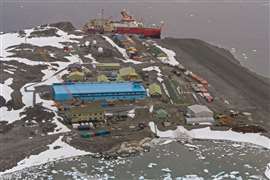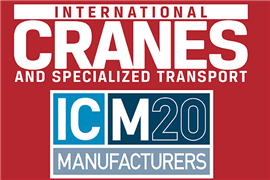Tunnelling: Underground successes
28 November 2017
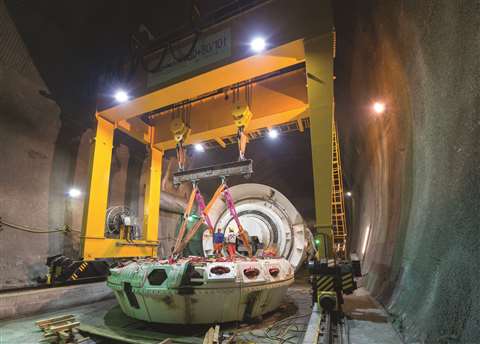
Scandinavia is a major focus for tunnels this year as the Stockholm bypass accelerates and TBMs (tunnel boring machines) for Oslo’s 20km long high-speed rail link push forwards.
But there are three major schemes in Austria, and Italy is seeing both a 34km long fast rail link from Milan to Genoa underway, and the biggest diameter tunnel in Europe beginning.
France has launched its huge peripheral metro scheme for Paris, and Germany’s Stuttgart 21 scheme starts its final 8km long rail tunnel.
But first mention goes to the three great Alpine links. The busiest is the Austria-Italy railway base tunnel beneath the Brenner Pass, a complex of three parallel tunnels 55km long and up to 1,800m deep.
It comprises two 8.1m diameter main bores, and a smaller exploratory and service tunnel beneath them, plus connections to the 9km Innsbruck bypass making some train journeys a world record 64km long. Numerous access tunnels are now mostly finished.
Major contracts presently include a €425 million package with a Strabag/Salini-Impregilo consortium at the north end making new accesses and a new service tunnel for the existing double track bypass, and excavation of large chambers for both a future safety station and 3km of the eventual main tunnels. Drill and blast for all this was completed this summer and fitting out continues.
Work there also includes a 15km drive south to extend the existing 6km of 5.5m diameter service tunnel. A Herrenknecht TBM is 8km into this. Part of its purpose is to ensure difficult potentially squeezing rock can by traversed by larger TBMs on the two main drives later.
It will emerge at the end point of the 3.2km Wolf access tunnel which has now been completed, joined to a short 1.2km service tunnel section being built southwards as part of Swietelsky/Swietelsky Tunnelbau’s almost complete work, in a €108 million contract.
Crushed rock
Further south in Italy, as reported last year, 3.7km long sections of main and service tunnel through the difficult crushed rock Periadriatic fault zone were completed at the end of the Mules access tunnel. Now work is underway here for the rest of the Italian side excavation up to the border, under a huge €993 million contract let in May 2016 to an Austro-Italian consortium led by Astaldi.
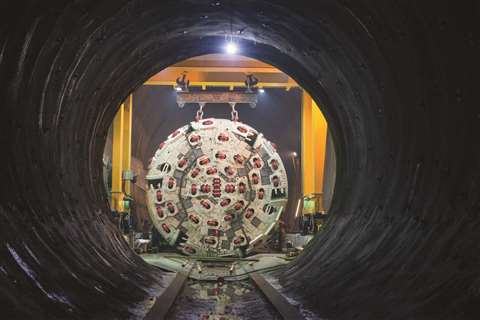
Over seven years, 39.8km of main tubes and 14.8km of exploratory tunnel will be excavated, plus the emergency stop in Trens and its access tunnel, as well as cross passages every 333m.
At the south portal, challenges of another kind are being met for the €303 Isarco River underpass led by RTI Salini-Impregilo.
Very soft waterlogged ground means extensive jet grouting and ground freeze tunnelling. Shafts and access tunnels are finished, and the main excavation is underway linking the line to the existing railway. There is also some 3km of the main tunnel bore to excavate.
France, together with Italy, has its own two decade long trans-Alpine high-speed rail base tunnel project in the 57km long Lyon-Turin link under the Frejus pass. Last access tunnel work in Italy has just completed and the first of the main drives, a 9km section of one side of the twin 10.5m diameter main bore has been underway for over a year.
The section is considered a test tunnel in difficult potentially squeezing ground. It uses a French NFM TBM with a maximum 11.2m diameter to allow overcutting to compensate.
So far it has driven 1.5km, according to the client, Tunnel Eualpin Lyon Turin (TELT), and despite some early difficulty is making 10m a day for contractor Spie Batignolles.
Switzerland is proceeding with the second major tunnel on its Alptransit Gotthard route, where the main 57km tunnel has been in operation since last year. The drives on the 15.4km Ceneri base tunnel to the south were completed last year, and now concrete rail bed and trackwork has finished on some 6km of 30km. The tunnel comes online in December 2020.
High-speed trains
Austria has two other major tunnels underway. Its longest is the 32.9km Koralm on the new Koralm rail line between Klagenfurt and Graz, and also the difficult 27.3km Semmering base tunnel north of Graz towards Vienna. Both are for high-speed trains at 250km/h.
The main 19km central section at Koralm began in 2011 with two Wirth TBMs driving the main hard rock section for contractor Strabag, installing a concrete lining as it went.
The machines faced difficult blocky and extremely hard rock, and have several times been stuck – the last being on both bores for three months in faulted ground this summer. A hand-dug side bore has now freed the shield. Breakthrough, originally for 2017, will now be early next year.
Another 1,800m of the south drive remains. Most of that is in another contract where Porr has to complete a 12km section driving the other way by drill and blast.
Porr is also doing a TBM drive for the north bore, where a convertible soft and hard ground Herrenknecht machine has done 5km of a nearly 12km drive, having also faced difficult rock.
Strabag has only another 500m to complete its 16.5km north drive “but the client has extended that by 500m, and perhaps another too,” said the contractor’s Dr Robert Goliasch. That would help catch up the opposing north drive.
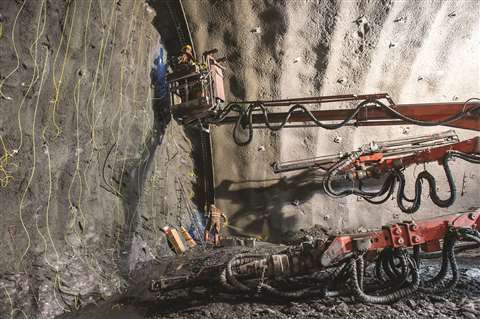
Client ÖBB Infrastruktur reports satisfactory progress at Semmering. Two 7km sections come in from the end portals, each by drill and blast. Gloggnitz also has an access tunnel with two 250m shafts from which conventional drives are being made, and was begun first in 2015 by a joint venture of Implenia, Hochtief Infrastructure and Thyssen Schachtbau. The Grautschenhof was begun last year by Swiss joint venture of Marti, with Marti Tunnelbau.
Earliest and most complex is the central Fröschnitzgraben section. This is accessible only from a high valley where two 400m deep shafts were built from 2014 the Implenia and Svedelski joint venture. From these a major cavern is being excavated beneath to launch two TBMs and to serve as the emergency station later on. The machines arrive in 2018 for two 9km drives, while 4.4km conventional drives will go towards Grautschenhof. High pressure water is expected in some sections.
Also in Austria, two 6.53m diameter, double shield Robbins TBMs have been restarted for the Gemeinschafts Kraftwerk Inn (GKI) joint Swiss-Austrian hydro power project in the Tyrol.
Contractor Strabag took over the scheme begun two years by a local consortium with Hochtief. The machines, working outwards from a central adit point, achieved 3km of 22km, but one machine had become stuck in difficult rock.
Follo line
In Norway, meanwhile, progress is good for the four Herrenknecht hard rock TBMs which set out, one per month, last September, driving 20km of twin bores north and south for the Follo line from Oslo to Ski. The first two had progressed more than 5,000m northwards in October this year, while the southern drives were at approximately 3,500m and 3,200m.
Bores are through typical hard Norwegian Cambrian gneiss with few faults expected, according to extensive pre-investigation work. Each is lined with concrete segments from the central site precast factory.
A complex final 1km near Oslo is being done with conventional drill and blast, and is also one of the first uses of hydraulic rock splitting to avoid vibration near a spaghetti of other road rail and water tunnels, also passing successfully some underground oil storage caverns.
Elsewhere, Norway’s railway authority has seen the completion of another major drive, which is the first using a TBM for some decades in a country which usually uses drill and blast.
Doubling of the 7.8km long Ulriken rail tunnel, close to Bergen, meant boring close to the existing live traffic tunnel, and vibration reduction was a major factor. An initial 800m was done with conventional methods to allow for crossover tracks in a wider profile.
The 7km Herrenkencht TBM drive broke through on 29 August, later than expected thanks to a slowdown in the first half of the drive where the sedimentary rock was of a lower quality than thought, “costing some eight months’ delay at one point,” said construction manager Helge Tjelmeland for Norways’ state-owned rail infrastructure company Bane NOR.
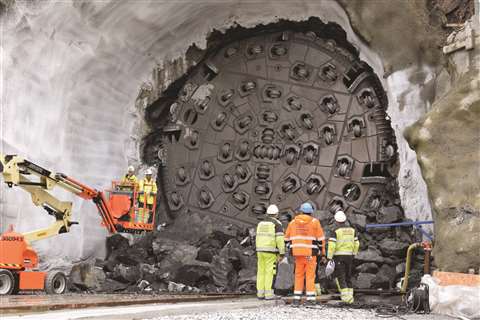
“Because of the previous tunnel, we knew there was a fracture zone, but it was more extensive than expected,” he said.
Over 40m of very heavy rock support was needed. Insulation, rail fit out and signalling all come next, and the tunnel opens in 2021.
In Sweden, work is ramping up for the giant city bypass, to the west side of the city beneath parkland, lakes and nature reserves. Two massive underground tunnels will run over 20km in hard rock, with three lanes of traffic each plus underground interchanges. There are another 14km of off and on ramps, access tunnels and ventilation shafts up to 70m deep.
Early work began last summer on adits and access with 3km of tunnel complete. Virtually all of six major contracts for the tunnels have been let, as well another six for above ground works, said project director Johan Brantmark.
The project design and construction is also working well with its computerised design and information management and co-ordination systems, which is part of Sweden’s national effort to switch to BIM (building information modelling) methodology.
Stuttgart 21
Germany has its own giant project the €5.53 billion multi-tunnel and underground station restructuring on the Stuttgart 21 project, using underground links to reconfigure local and high-speed lines in a city surrounded by hills.
Work is underway on half a dozen tunnels, including complex work on the 9km Filder high-speed rail tunnel to the airport, where a band of potentially expansive anhydrite rock meant the drive was in three sections for each of its two bores.
A Herrenknecht TBM does the top and bottom section, while drill and blast with special dry techniques is used for 2.5km in the middle.
This has gone well, with the TBM completing both top sections and now pulled through the completed middle to begin on the 3.6km long downhill bottom drive. Finally, it will turn in a cavern to do the last section uphill in the other bore.
Other tunnels like the Feuerback also have anhydrite requiring specially modified drills for dry operation supplied by Sandvik.
The 21 project connects to a simultaneous high-speed link from Stuttgart to Ulm, with a clutch of major tunnels up to 8.2km, mostly through the high Schwäbischer Alps national park.
The last tunnel comes in the lower ground of the Albvorland alongside the A8 Munich Autobahn. It is an 8.2km tunnel under mostly farmland with as little as 8m cover for several hundred metres, and up to 65m.
Contractor Implenia began work last year and assembled two Herreknecht EPB (earth pressure balance) machines side by side this summer. To avoid ground disturbance interactions, they will have staggered starts with the first due to set off in October for the parallel tubes.
Biggest ever TBM
Giant projects are also underway in Italy, with Europe’s biggest ever TBM, a 15.87m diameter Herrenkencht EPB starting a 7.52km drive in May for the Santa Lucia road tunnel south of Bologna. It has completed 700m so far.
The tunnel will form a three-lane northbound section for the country’s A1 spine motorway link in the Apennines towards Florence. An existing two-way tunnel will be renovated for traffic the other way.
The machine is similar to one used for the nearby completed Sparvo tunnel, and like that must deal with potential methane in mixed ground, contractor Pavimental said.
Engineer Claudio Mandinici, who came from the Sparvo project, said, “We have used experience from Sparvo to enhance the design.”
Work is in soft clay initially and then harder limestone for about 75% of the drive, where he said improved gas monitoring might allow the TBM to run in open mode. Cover is as low as 11m and up to 270m.
Italy also is well along with works on its own long high-speed rail tunnel, a 34m low gradient base tunnel system through mountains around Genoa to improve the route to Milan.
Two twin bore tunnels, the 7km Serravalle and then the 27km long Valico make up the tunnel portion of an overall €4.5 billion 53km long rail project for 250km/h trains to open in 2021.
The main contractor, the Italian Salini Impregilo Consorzio Collegamenti Integrati Veloci (COCIV), is doing the main tunnelling using conventional methods. But the northern 7.7km of the Valico and all of Serravalle are being built with four 9.73m diameter Herrenknecht EPB machines under a subcontract with Seli Overseas.
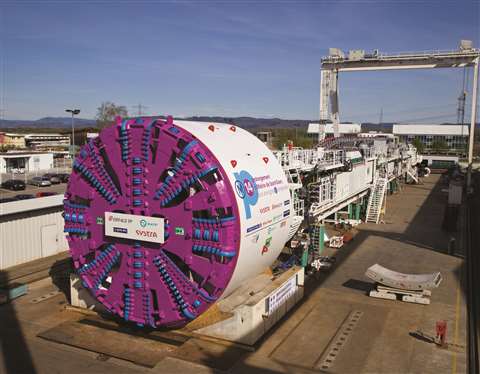
Paris will soon be a focus of attention too, with work starting on underground stations for the huge €28 billion Grand Paris Express which will eventually have 200km of new line, mostly underground.
This forms a peripheral rail-metro network with a main outer circle line around the city, and two further lines extending it, also as circular routes, to the east and the west. Another line runs across city centre, and a spur takes in Charles de Gaulle airport. Lines connect to Orly aiport also.
Rail tunnels should begin early next year with a 9.8m diameter Herrenknecht machine due to be delivered at the end of this year. The large diameter will accommodate both tracks. The first lines are due to open in 2024 to synchronise with the Paris Olympics.
Water tunnel
Further afield, Turkey has been battling to complete the 31.6km Gerede water tunnel, a supply for drought hit capital city Ankara.
US maker Robbins recently supplied a dual mode machine, launched last year, for the final 9km of tunnel. It has to cross dozens of fault zones and withstand intense water pressures up to 20 bars.
According to Robbins, earlier phases used double shield machines from Europe, but karstic conditions and extreme water inflows caused difficulties for the job. One machine was abandoned and another was stuck.
It said, “For the last stage, a 5.56m diameter XRE (standing for a Crossover between Rock and EPB) could effectively bore conditions in both rock and mixed ground under water pressure by converting between modes.
“Revised geology is now understood to contain more significant fault zones and an aquifer system that could cause high-pressure water inrushes of up to 20 bar.”
However, the ground was expected to improve as the TBM advanced and to consist mostly of sandstone, limestone and tuff with a maximum hardness of around 100MPa.
In Albania, a hydropower project in the small town of Moglicë, again used a Robbins crossover machine – this time of 6.2m diameter.
Joint venture contractor Limak/AGE is using the dual mode hard rock and EPB type machine to get through 6.7km of ophiolite, flysch, mélange and breccia. The machine must handle sudden water inflows up to 20 bar for which it has special seals.
The 242MW scheme is part of the Devoll hydropower for Norwegian-owned client Statkraft, and is designed to increase the country’s power supply significantly.
STAY CONNECTED


Receive the information you need when you need it through our world-leading magazines, newsletters and daily briefings.
CONNECT WITH THE TEAM









